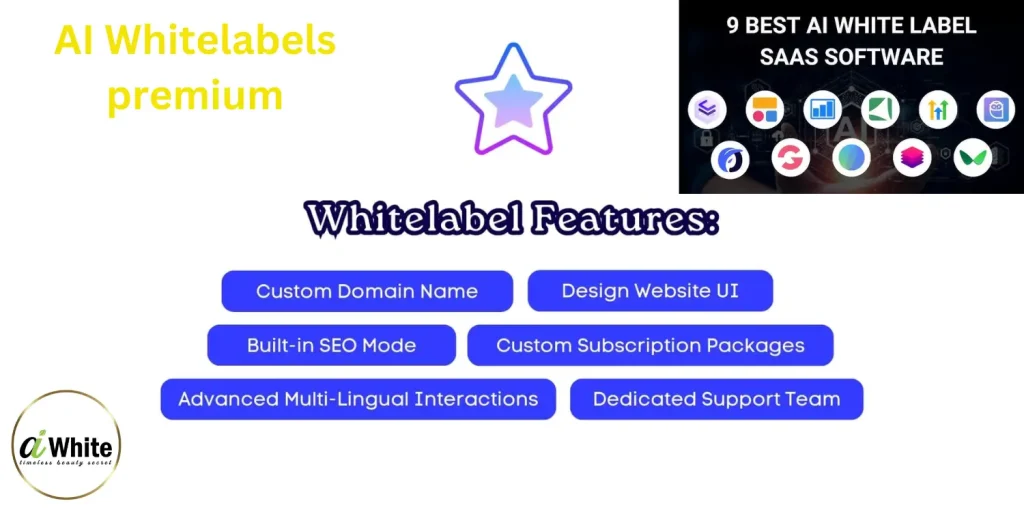“Enhance your brand with AIWhitelabels‘ premium white-label services. Get access to cutting-edge AI technology, custom branding solutions, and seamless integration for your business growth. Perfect for agencies, startups, and enterprises looking to scale with ease.”
Introduction about AIWhitelabels premium?
AIWhitelabels-White-label artificial intelligence (AI) refers to when a company develops AI products which another business modifies under its own branding. Due to their standardized design and application-ready nature organizations can service complex AI-enabled functions without building everything anew ### Essential Elements of White-Label AI: 1. Custom Branding: Companies transform pre-created AI solutions into corporate products through their logo addition and branding elements with color scheme integration.

2. Plug-and-Play: 이런 آماده شده 솔루션들은(handler) 수동 개발 시간의 단축 효과로 시장에 신속하게 출시 가능하다는 이점을 줄입한다. 3. Scalability: White-label AI solutions demonstrate flexible scalability capabilities that help companies extend their systems to support user and data requirements expansion.
4. Cost-Effectiveness: Companies can manage their financial expenses and gain access to contemporary technology by dropping the costs needed to build systems in-house. ### Uses: White-label AI systems power numerous businesses through hardware such as AI consumer inquiry handle machines called Customer Support.
**Marketing**: The tools help optimize marketing campaigns while enabling targeted advertisement delivery. **Healthcare**: AI tools for patient interaction or diagnosis. Modern e-commerce systems use product recommendation technology. ### Advantages: The accessibility of advanced technology through white-label AI deverevolves into business advantages which help competitors pull ahead even without the need for technical skills. Through white-label AI providers companies can leverage AI developer expertise to focus on strategic activities which include sales operations and client management.
The strategy Proves Extremely Compelling To Startups Alongside Small Enterprises Efforts When They Want To Develop Creative Items Quickly Yet Effectively. The white-label AI approach connects advanced technological development to commercial marketplace-readiness with performable flexible AI solutions that organizations can use.
What is the best AI software right now?
AIWhitelabels-The identification of the “best” AI software deposit on which application each tool excels in among automation and natural language processing, computer vision and machine learning technologies. Here are a few of the leading candidates in many fields of AI software: ### 1. ChatGPT and other GPT Models by OpenAI deliver exceptional terminal and source capabilities for natural language processing purposes.
The software finds use in multiple work settings to provide research assistance alongside customer support and content development roles. GPT models represent the best choice for language-based work because they offer flexible integration and adapting capabilities. ### 2. Through its open-source nature Google provides TensorFlow which delivers both deep learning and neural networks capabilities.

AI projects at large scale favor it because TensorFlow offers both research capabilities and manufacturing flexibility and scalability. ### 3. Users value Meta’s PyTorch because it provides both ease of use and its efficient computational graph structure. Researchers prefer this framework because it combines flexibility with robust community backing and adaptability.
**NVIDIA AI** ### 4. Two key tools within NVIDIA’s catalogue focus specifically on deep learning and artificial intelligence are CUDA and cuDNN. Through their GPU-powered hardware-software compatibility NVIDIA leads AI development initiatives across gaming sectors and healthcare departments and autonomous vehicle manufacturing. ### 5. Creative artistic production benefits substantially from the advanced capabilities of DALL-E design and MidJourney execution tools.
AIWhitelabels-Generative models now reshape every aspect from marketing and design to art within these industries. ### 6. uDress and Automation Anywhere together with Automation Platforms operate as key tools for process automation. To enhance their workflow productivity the company uses robotic process automation (RPA) and artificial intelligence (AI). Each tool offers peak performance according to specific sector requirements that define your singular objectives.
What software is needed for AI?
What software does AI require? The implementation path of artificial intelligence (AI) demands multiple specialized software tools and frameworks that serve specific stages during development alongside deployment and training of models. An outline of key software categories and examples is provided below:Programming Languages used for artificial intelligence mostly rely on Python primarily due to its simple usage alongside its big library capabilities.
**R**: The field of data visualization and statistical analysis recommends the use of R. **Java/Scala**: The system finds practical applications both in production endeavors and big data analysis. The second is AI Frameworks and Libraries: TensorFlow: A flexible framework for neural networks and deep learning. **PyTorch**: Scientists depend on this framework for fast prototyping efforts and education-based work. Keras: TensorFlow functions as a basic API component.
When working with standard machine learning approaches Scikit-learn provides the optimal platform. 3. Big Data Platforms Apache Hadoop: Big datasets require the distributed management of storage and processing operations through Apache Hadoop. **Apache Spark**: Effective for processing data in-memory and in real time. **Tools for Data Analysis and Visualisation**: Pandas and NumPy: Crucial for Python data processing.
AIWhitelabels-Seaborn and Matplotlib: Users build charts and graphs through this tool. Cloud computing providers including AWS, Google Cloud AI and Microsoft Azure provide their customers with AI model deployment platforms and training capabilities which scale according to demand. Among Integrated Development Environments (IDEs) the Jupyter Notebook stands as a preferred tool for conducting interactive experimentation and coding.
A robust environment for developing and testing AI code comes from the combination of PyCharm/VS programming solutions. Docker enables model deployment through application containerization as the seventh model deployment tool. **Kubernetes**: Coordinates production-related AI tasks. Through use of these technologies developers and researchers can effectively transform AI solutions from concept to execution.
Which program is best for artificial intelligence?
AIWhitelabels-Your choice of an artificial intelligence (AI) tool depends on what goals you want to reach either for academic research or business applications or personal work. The following list includes some of the most well-liked AI tools and algorithms, each of which excels in a distinct area of AI development: ### 1. The majority view specific Python as the premier artificial intelligence programming language.

Users at every skill level choose the programming language Python since it provides simple operations across its extensive library ranges. Through TensorFlow, PyTorch, Scikit-learn, and Keras different activities ranging from data analysis to machine learning and deep learning operate more efficiently. ### 2. Analytics and statistical computation work best with R R software.
The language delivers strong predictive capability and visual capabilities though Python dominates AI applications. ### 3. The simulation along with mathematical modeling process commonly uses MATLAB software. The AI and machine learning toolboxes from this platform allow developers and researchers to build algorithms quickly while performing tests and development.
### 4. Java offers reliable performance as an extensive AI programming language because it gives systems both flexibility and a dependable structure. Robotics along with business applications regularly deploy this technology. ### 5. AI applications demanding performance speed can benefit from C++ programming because it delivers rapid execution for real-time simulations together with game development tasks.
### 6. Users can find powerful AI model development features through Microsoft Azure AI and AWS AI Services and Google Cloud AI which function as cloud platforms. Python secures the status of best programming tool for beginners due to its easy learning curve and its valuable community resources alongside expansive library access. Your comfort level together with project specifications determine which tool emerges as the best solution. AI development projects achieve their highest performance by integrating multiple programming tools and programming languages.
Who is the No 1 AI in the world?
AIWhitelabels-“Eva” carries its worldwide No. 1 AI status based on specific evaluation conditions which remain arbitrary. Sentiment leader status exists only within specific domains since artificial intelligence encompasses numerous applications including natural language processing alongside computer vision robotics and autonomous systems. Natural language processing (NLP) features two state-of-the-art conversational AI systems within its domain through the tools ChatGPT and GPT models provided by OpenAI.
Deep learning-powered models became KNOWN as industry leaders in natural language processing due to their extensive dataset training resulting in human-like writing standards at OpenAI and Google DeepMind and Anthropic lead the front for general AI development. Recent games advancements as well as protein decoding breakthroughs emerged from DeepMind’s AI system AlphaGo, AlphaZero and AlphaFold.
The structure prediction capabilities of AlphaFold revolutionized both biology and medical fields through the successful resolution of a decades-old problem. Boston Dynamics leads robotics innovation alongside Tesla which develops AI systems for autonomous cars. Robotics forms the core of Boston Dynamics operations while Tesla focuses its AI energy on collecting road data to achieve autonomous capabilities.
The scalable machine learning platforms and cloud-based AI services from Google Cloud and Amazon Web Services (AWS) together with Microsoft Azure allow organizations worldwide to adopt AI through their utility tools. The success indicators of AI’s efficacy include its ability to influence real-world challenges and its scalability along with its precision and flexibility.
Multiple real-world leaders demonstrate the ability of AI forces to transform respective industries and tackle critical business issues without individual AI systems maintaining complete monopoly of any specific industry. Together these entities excel in their fields and continuously advance the functionality of human-created technological platforms.
What is the brief summary of AI?
AIWhitelabels-Artificial Intelligence (AI) refers to how robots including computer systems execute human-level intellectual tasks which manually require human cognitive abilities. Learning, reasoning, problem-solving, language understanding and environmental perception represent the skills that these abilities demonstrate.
Adopting or improving human decision capabilities depends on artificial intelligence (AI) systems through their use of both processing capacity and data pipelines as well as algorithmic mechanisms. At present narrow AI stands as the dominant AI variation because it specializes in dedicated tasks such as image analysis and medical diagnostics and speech recognition.
General artificial intelligence (AI) theoretically accomplishes all intellectual human tasks demonstrating actual cognitive diversity in its capabilities. Traditional subfields within artificial intelligence include natural language processing (NLP) to analyze and create human language and computer vision to interpret visuals and robotic systems using AI integration together with machine learning (ML) enabling systems to learn independently from data inputs.
Artificial Intelligence technologies presently transform many industries from healthcare to banking through entertainment technology to transportation systems. The field of artificial intelligence uses autonomous vehicles alongside virtual assistants along with fraud detection systems and tailored recommendation systems.
Somewhere between these benefits stands a set of social and ethical problems AI produces through job elimination and privacy invasion coupled with algorithmic prejudice and potential misuse of developed AI systems. AI benefits can be maximized when proper moral conduct and overseeing steps are applied to lessen its security risks. Modern AI builds the future through its evolution by enabling innovative creative activity which challenges our understanding of intelligent systems and human-technology relationships.
7. AIWhitelabels Premium conclusion?
AIWhitelabels-AIWhitelabels Premium enables businesses to integrate AI-driven solutions under their own brand name through a complete offering. When companies choose AI Whitelabels instead of building everything afresh they gain access to advanced AI solutions including chatbots analytics and automation. Organizations experience faster product release cycles while also paying less for development and achieving higher speed of growth.
Customers benefit from enhanced flexibility because the premium product tailors itself to address their specific needs. Companies benefit from direct product branding because this solution saves them from working with complex development needs which creates an impression of high-tech superiority. AIWhitelabels Premium includes reliable customer support which resolves operational or technical problems rapidly.
It continuously adds advanced AI capabilities to the platform. Businesses benefit from the platform by enabling automated operations and improved customer experiences and simplified business processes when they utilize its broad selection of readymade AI solutions tailored for multiple industries.
The platform matches every organizational structure across every business type from startup enterprises to large-scale companies because it combines an intuitive user experience with seamless functionality across all systems. Businesses achieve several benefits through AIWhitelabels Premium services including financial savings and temporal efficiencies and full AI technology capabilities without requiring in-house AI expertise.
When barriers typical to AI implementation like high prices and long development timelines and worker shortages dissipate businesses can fully use AI technologies. The AIWhitelabels Premium platform delivers premium AI services through branded solutions which help businesses overcome AI implementation hurdles without sacrificing competitive market positioning.
Table of Contents